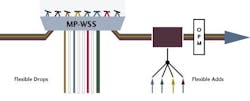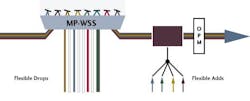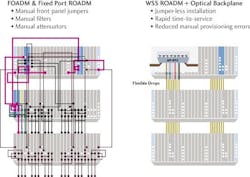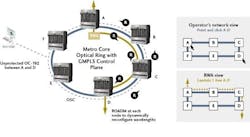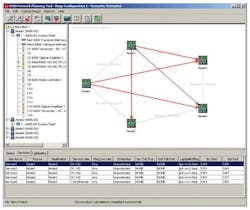ROADMs need complementary technologies to realize opex value
The value proposition of ROADM-based systems is rooted in the opex savings they can deliver. To realize those savings, however, systems require complementary features beyond the ROADM subsystem.
By Rich Ramsay, Meriton Networks
DWDM network operators are always looking to simplify their networks and make them simpler to operate and manage. Operating expenditures, which can account for up to 80% of total network costs, jeopardize margins and business models, especially in the face of falling prices. Limitations of legacy DWDM technologies have increased opex, often because highly trained engineers are required to perform numerous, labor-intensive manual tasks. Network engineering is a complex exercise requiring a multitude of spreadsheets, and any changes result in the need to reengineer the network. Network planners are forced to predict future traffic and preplan bandwidth to avoid upgrade disruptions or stranded capacity.
However, there is a better option. Network operators are deploying record numbers of reconfigurable optical add/drop multiplexers (ROADMs) to simplify network management and reduce opex. ROADM-based systems offer network operators enhanced flexibility and automation, and their value proposition is rooted in the opex savings they can deliver. To realize those savings, though, such systems require many features beyond the ROADM subsystem.
The ROADM subsystem
The key capabilities of advanced ROADMs include remote reconfigurability, single-wavelength granularity for directing wavelengths to drop or express paths, and per-channel power monitoring and equalization to support automatic and dynamic adjustments to changes within the network. Ring-based applications require two degrees of optical connectivity, but network topologies like physical mesh, linear spurs off a ring, and interconnection of rings recently have introduced the requirement for higher degrees of optical connectivity. To achieve this required functionality, ROADM subsystems must integrate several functional features, including:
- Multiplexing and demultiplexing of all channels.
- All-optical switching to any port and over more than two degrees.
- Per-channel power monitoring and power balancing.
Of the various ROADM architectures that exist, a wavelength-selective switch (WSS) best meets all these requirements. Because a WSS has the ability to direct any or multiple wavelengths to any fiber port, it provides a superior path toward scalability and migration to multidegree (more than two-degree) topologies.
A WSS architecture is shown in Figure 1. The WSS's colorless ports and inherent ability to direct any one or multiple wavelengths to any drop port paves the way for low-cost optical ring interconnection or physical mesh nodes with multidegree optical connectivity. However, a full-featured ROADM subsystem will not only provide this flexible wavelength switching, it will also integrate other key features, including multiplexing/demultiplexing and per-channel power monitoring and balancing.
Simplifying networks
The ROADM's ability to remotely reconfigure (via optical switching), monitor, and dynamically balance wavelengths has drastically simplified planning, provisioning, and network management. Yet the full value of the ROADM is further enhanced when it is coupled with complementary system technologies that further enable simplified networking, including:
- A fully automated optical layer with automatic gain-controlled amplifiers and per-channel power balancing.
- Optical backplanes for jumperless installation and provisioning.
- Tunable laser transponders to take full advantage of the colorless WSS ROADM ports.
- A generalized multiprotocol label switching (GMPLS) control plane for bandwidth allocation, resource and topology discovery, and real-time provisioning.
- Advanced software for network planning and management.
Automated optical layer. While many OADM implementations provide only broadband, non-real-time optical power monitoring of the aggregate DWDM signal, a full-featured ROADM system will provide real-time, per-channel power monitoring and power balancing. With this feature, operators can avoid costly and time-consuming manual adjustments of optical power levels when adding or deleting wavelengths from a network. In addition, real-time, direct measurements are reliable and provide for rapid fault isolation. As an added benefit, per-wavelength power balancing within the ROADM subsystem simplifies the design and reduces the cost of optical amplifiers that might otherwise require dynamic gain equalization (DGE) techniques.
Advanced ROADM systems should include variable gain amplifiers with fast transient control, providing continuous, automated broadband gain adjustments to correct for changes in span losses or the channel power load. Combined with the WSS features, per-channel and broadband optical power-level management can be fully automated and dynamically controlled, simplifying optical layer design, management, and operation and reducing the associated opex.
Optical backplane. While few ROADM system vendors offer jumperless provisioning via integrated optical backplane cabling, this feature greatly simplifies the installation, provisioning, and reconfiguration operations. In this scenario, an optical backplane is preconfigured so that the many manually placed front-panel optical interconnect jumpers are eliminated, and connections are established at the rear of the chassis. Optical connectors on the back of each circuit pack engage with the optical backplane when plugged into the chassis. When provisioning lightpaths, the only required optical jumper connection is from the client service to the transponder service port. This feature eliminates significant labor, the mess associated with front-face jumpering, and the potential for incorrect connections.
Tunable lasers. While the value of tunable lasers is obvious for sparing, availability, and equipment reuse, their flexibility and remote tunability is an important complement to a ROADM-based system. Widely tunable lasers (covering the full channel plan), coupled with a colorless-port WSS with single-wavelength granularity, enable simplified provisioning and dynamic wavelength management. These features eliminate the need to match fixed-wavelength lasers with fixed-wavelength filters. Instead, operators can simply point and click to remotely provision wavelengths, again benefiting from the operational simplicity of these combined system features.
GMPLS control plane. Recently, GMPLS-integrated control planes have been used to automate provisioning. This control plane supplies the intelligence and messaging over an optical supervisory channel to control the ROADMs in the network. GMPLS enables nodes to seamlessly work together in a network to provide resource and inventory auto-discovery, topology information, service setup, signaling, path computation, lightpath setup, and management.
Figure 3 demonstrates the simplicity of managing services in a ROADM-based network, complete with a GMPLS control plane and automated optical layer. Once a user initiates the request for a new service—which is a "point-and-click" operation—a message is sent to a gateway node signaling the request for the new lightpath or service. This message is forwarded to the headend node via an optical supervisory channel. Since each node knows the resources of all the other nodes on the network, the headend node chooses the optimal wavelength and path. Resource reservation messages are sent to the relevant nodes to reserve the required resources along the path, and acknowledgements are returned to the headend node. The setup of add, pass-through, and drop wavelength states in the ROADM subsystem is then signaled to all relevant nodes, and the lightpath is established. With a fully reconfigurable, flexible-port ROADM, lightpath setup can be accomplished without the network operator ever touching a fiber.
Network design. Ideally, network planners would strive for one-time network engineering, allowing unrestricted and nondisruptive addition/removal of services and wavelengths to the network at any time. This notion of any-node-to-any-node wavelength connectivity can be a complex and time-consuming challenge unless a sophisticated planning tool is available.
Advanced, software-based network planning tools now fully automate the optical layer design as well as the traffic routing, guaranteeing any-node-to-any-node performance with all supported data rates and service types. While advanced software helps minimize the capital expenditure associated with network design, such tools also provide operational benefits by virtue of reduced design cycles and ease of exploring various scenarios.
In summary, ROADM-based systems with advanced automated features offer:
- Simplified network planning and engineering with greater network flexibility and advanced planning tools.
- Installation and commissioning in hours versus weeks.
- Service provisioning in minutes.
- Minimal or no reengineering or service disruption with revised traffic patterns.
- Simple network growth and expansion with automated procedures.
With a ROADM-based service transport system, it is now possible to remotely provision and manage a network with simple, remote, point-and-click provisioning. The technologies and features that surround the ROADM subsystem play a significant role in the value of the system and support the promise of reduced opex. With these additional features, the resultant system automates OAM&P, reduces provisioning time, efficiently utilizes resources, increases service flexibility, and substantially reduces opex and the total cost of ownership.
Rich Ramsayis a product manager at Meriton Networks. Ramsay received his masters degree in telecommunications from the University of Colorado, and he has 20 years of business and technical experience in the optical fiber and telecommunications equipment industry with companies such as AT&T Bell Laboratories, Lucent Technologies, and Furukawa Electric. He may be reached via the company's web site at www.meriton.com.
